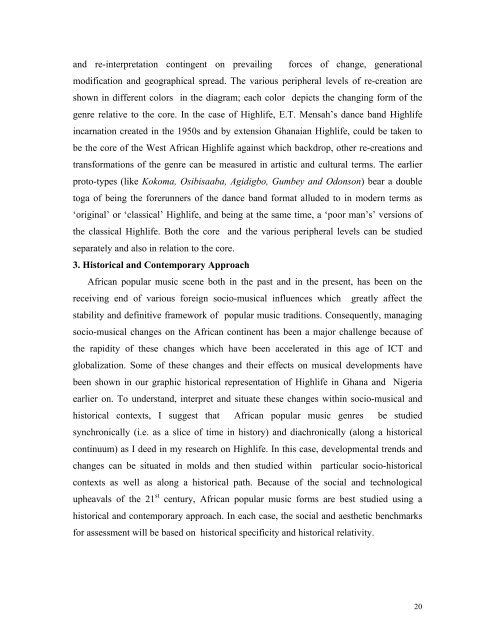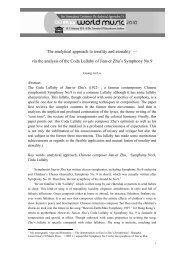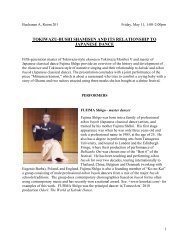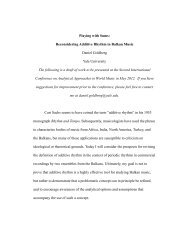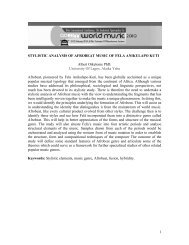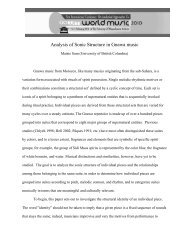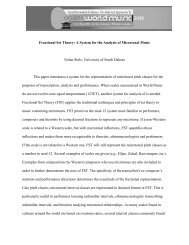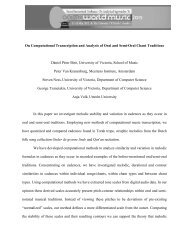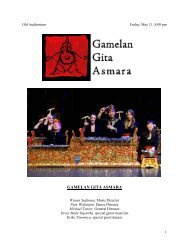A Case Study of Highlife Music - Analytical Approaches to World Music
A Case Study of Highlife Music - Analytical Approaches to World Music
A Case Study of Highlife Music - Analytical Approaches to World Music
You also want an ePaper? Increase the reach of your titles
YUMPU automatically turns print PDFs into web optimized ePapers that Google loves.
and re-interpretation contingent on prevailing forces <strong>of</strong> change, generationalmodification and geographical spread. The various peripheral levels <strong>of</strong> re-creation areshown in different colors in the diagram; each color depicts the changing form <strong>of</strong> thegenre relative <strong>to</strong> the core. In the case <strong>of</strong> <strong>Highlife</strong>, E.T. Mensah’s dance band <strong>Highlife</strong>incarnation created in the 1950s and by extension Ghanaian <strong>Highlife</strong>, could be taken <strong>to</strong>be the core <strong>of</strong> the West African <strong>Highlife</strong> against which backdrop, other re-creations andtransformations <strong>of</strong> the genre can be measured in artistic and cultural terms. The earlierpro<strong>to</strong>-types (like Kokoma, Osibisaaba, Agidigbo, Gumbey and Odonson) bear a double<strong>to</strong>ga <strong>of</strong> being the forerunners <strong>of</strong> the dance band format alluded <strong>to</strong> in modern terms as‘original’ or ‘classical’ <strong>Highlife</strong>, and being at the same time, a ‘poor man’s’ versions <strong>of</strong>the classical <strong>Highlife</strong>. Both the core and the various peripheral levels can be studiedseparately and also in relation <strong>to</strong> the core.3. His<strong>to</strong>rical and Contemporary ApproachAfrican popular music scene both in the past and in the present, has been on thereceiving end <strong>of</strong> various foreign socio-musical influences which greatly affect thestability and definitive framework <strong>of</strong> popular music traditions. Consequently, managingsocio-musical changes on the African continent has been a major challenge because <strong>of</strong>the rapidity <strong>of</strong> these changes which have been accelerated in this age <strong>of</strong> ICT andglobalization. Some <strong>of</strong> these changes and their effects on musical developments havebeen shown in our graphic his<strong>to</strong>rical representation <strong>of</strong> <strong>Highlife</strong> in Ghana and Nigeriaearlier on. To understand, interpret and situate these changes within socio-musical andhis<strong>to</strong>rical contexts, I suggest that African popular music genres be studiedsynchronically (i.e. as a slice <strong>of</strong> time in his<strong>to</strong>ry) and diachronically (along a his<strong>to</strong>ricalcontinuum) as I deed in my research on <strong>Highlife</strong>. In this case, developmental trends andchanges can be situated in molds and then studied within particular socio-his<strong>to</strong>ricalcontexts as well as along a his<strong>to</strong>rical path. Because <strong>of</strong> the social and technologicalupheavals <strong>of</strong> the 21 st century, African popular music forms are best studied using ahis<strong>to</strong>rical and contemporary approach. In each case, the social and aesthetic benchmarksfor assessment will be based on his<strong>to</strong>rical specificity and his<strong>to</strong>rical relativity.20


